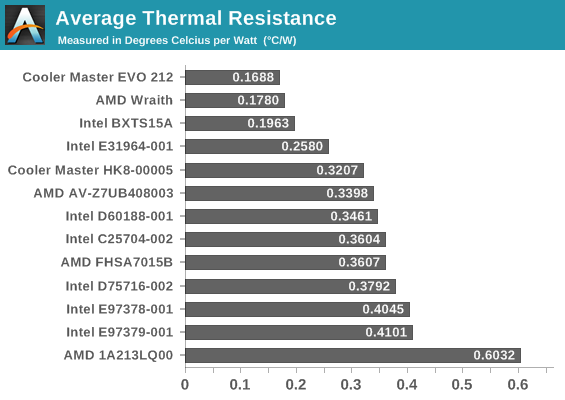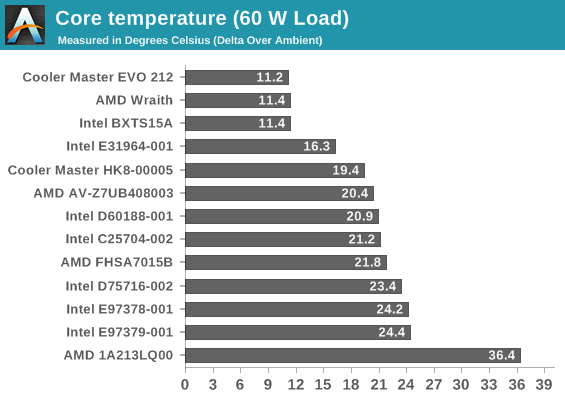Battle of The CPU Stock Coolers! 7x Intel vs 5x AMD, plus an EVO 212
by E. Fylladitakis on July 22, 2016 9:00 AM EST- Posted in
- Cases/Cooling/PSUs
- CPUs
- AMD
- Intel
- Cooler Master
- Cooler
Testing Results, Maximum Fan Speed (12 Volts)
Most of the stock coolers were tested with a maximum load of 150W, lest we start a fire. These products were not meant to handle thermal loads way higher than the stock specifications of the CPUs they were being shipped with.

Looking immediately at the average thermal resistance and we see three main coolers out in front, and it is no surprise that these three are the beefiest - the EVO 212, the Wraith and the BXTS15A. The small Kabini cooler is designed for very low power, and our small test here pushes it outside of its window.

| Core Temperature, Constant Thermal Load (Max Fan Speed) |
As we move up the thermal loads, from 60W all the way up, the coolers by and large stay in their positions, with small differences becoming more pronounced as the load increases.

The EVO's large 120mm fan keeps the RPM down here, and it is interesting to see the RPM and noise of the BXTS15-A go far and above the other coolers.

An interesting observation would be that Intel’s coolers meant for a specific socket have about the same absolute thermal resistance regardless of the core’s material. Taking socket 775 coolers as an example, the aluminum D75716-002 performs similarly with the copper C25704-002, most likely due to its solid core, and the tall copper D60188-001 also performs similarly due to the much slower (and quieter) fan. The same goes for the aluminum E97379-001 and the copper E97378-001 socket 1155 coolers, the former of which simply has a significantly more powerful fan attached. The E31964-001 performs significantly better but its high performance is not just due to its size and copper fins, as the fan is quite fast and loud as well.
In AMD’s camp, the simple and cheap FHSA7015B displays reasonable thermal performance at the expense of comfort, as the maximum speed of its fan is quite high. The more advanced AV-Z7UB408003 offers only slightly better thermal performance but noise levels were significantly lower. The Cooler Master HK8-00005 beats both of the aforementioned coolers in terms of thermal performance but its noise levels are rather high. This was to be expected, as it is based on the core design of the AV-Z7UB408003 but is significantly smaller, therefore a more powerful fan would have to make up for the loss of mass. Finally, the small 1A213LQ00 realistically has by far the worst overall performance of every cooler we tested here today, as the little cooler is designed with AMD’s power efficient AM1 CPUs in mind and cannot be directly compared to any of the other coolers in this review.
Both of AMD’s Wraith and Intel’s aftermarket BXTS15A stand out, pulling ahead in terms of performance the rest of the stock coolers. AMD’s Wraith is but a breath away from Cooler Master’s EVO 212 and the BXTS15A does not fall far behind. There is a catch though and that is the fans. Both the Wraith and the BXTS15A are making use of very strong fans, with a much higher top speed than that of the 120 mm fan that the EVO 212 is using. Strong fans are not just inherently louder themselves but the high air turbulence they create effectively multiplies the sound pressure level of the setup.










82 Comments
View All Comments
mikato - Thursday, July 28, 2016 - link
Is it noisy?yannigr2 - Friday, July 22, 2016 - link
AMD should start selling Wraith for $20. If they can make an Intel version, that would have been hilarious. An Intel CPU with a cooler on top of it having the AMD logo.silverblue - Friday, July 22, 2016 - link
It might make sense to re-test the Wraith without its shroud to see if it measures up to AMD's claims.Yuriman - Friday, July 22, 2016 - link
I'd personally find it a lot more useful if there were some charts showing temperatures with the coolers normalized for acoustic performance, or showing noise while normalized for core temperature or thermal resistance. It's not very useful to know that cooler A is both quieter and performs worse than cooler B when both are at 7v, because they're all PWM and will be targeting a temperature range, rather than running at a fixed fan speed.mikato - Thursday, July 28, 2016 - link
I agree. Noise is more important to me than this article made it.Einy0 - Friday, July 22, 2016 - link
Nice to see the EVO 212 is much better than most stock coolers. I have one on both my home PCs and my work PC. Glad to see the $30 investment is worth it... The wraith is sick, too bad AMD still doesn't have a nice cpu to put under it! I can't wait for Zen, I'm so sick of giving all my cpu money to Intel.Peichen - Monday, July 25, 2016 - link
Why sick of giving Intel your money? Are you not satisfied with the performance you paid for? Are you CPUs dying young?mikato - Thursday, July 28, 2016 - link
Maybe because he/she has the feeling that Intel is charging more for a given item than they would otherwise be if they had better competition, and he/she does not like paying more than may be normally justified.nismotigerwvu - Friday, July 22, 2016 - link
Very cool! It's nice to have a quantifiable value for the improvement an aftermarket cooler can provide. My only nitpick would be to see if a push/pull setup on the 212 was worthwhile. On my system it seems to be a bit quieter since I can keep the fans at a lower RPM, but it could also just be a placebo.Voldenuit - Friday, July 22, 2016 - link
My old Opteron 165 (Toledo?) came with a heatpipe cooler, so that definitely predates the AV-Z7UB408003 cooler that came with the Phenom X4.